Alignment & Balance of the Human Body.
Epistemic status: An introduction post for my Base-Line Theory of Human Health and Movement. Facts and definitions first ...
Introduction.
When referring to the human body,
What do balance and alignment mean?
Two (of the many) definitions for balanced:
1. Different parts of something that exist in equal or correct amounts.
2. A state of equilibrium, being in harmonious arrangement.
Alignment has many definitions, the two most relevant to 'body alignment' are:
1. Arrangement in a straight line.
2. Arranged in the correct relative positions.
Alignment, Balance & The Median Plane.
The median plane (a.k.a. midsagittal plane) is the plane that splits the body into left and right halves.
A straight line when viewed from the front or back. A 2-D shape from the side.
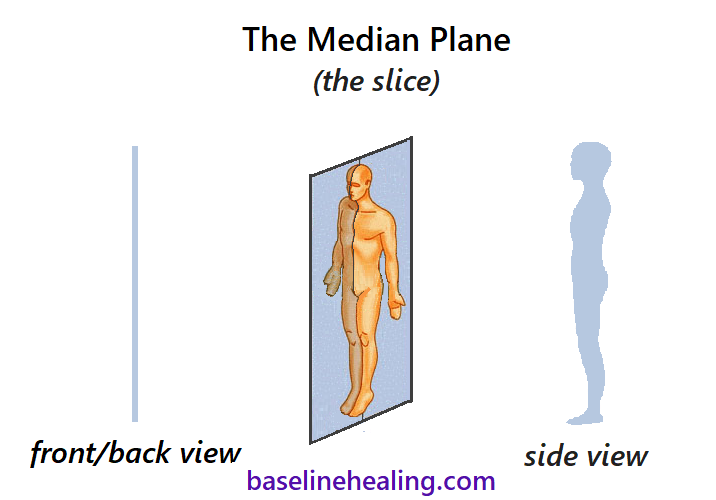
The body must be "correctly arranged" to create the median plane, where:
- The body is aligned.
- All midline anatomy is arranged on the straight line of the median plane.
- The body is balanced.
- Left and right sides in equilibrium either side of the median plane.
The position of the rest of the body should be considered relative to the midline anatomy and the median plane.
Midline Anatomy.
Palpable Anatomical Structures.
Some easy to find midline anatomical structures include the:
- Anus. (asshole)
- Pubic symphysis of the pelvis. (bone between the legs, front midline)
- Navel. (belly button)
- Xiphoid process of the sternum. (inverted "V" bottom of rib cage, front midline)
- Jugular notch of the sternum. ( "V" top of rib cage, front midline)
- External occipital protuberance. (back of head - midline bump at the base of the skull).
Feel for the relative positioning of these midline markers to increase your awareness of your body's midline.
Midline Linear Structures.
The linear anatomical structures on our midline need to be at full extension to be truly aligned - straight, smooth, no kinks or tensions so they can line up on the median plane.
The main linear structures we should focus on for body alignment are:
- The linea alba. Midline at the anterior (front) of the body.
- Our primary anatomical guide for body alignment.
- The nuchal ligament & supraspinous ligament. Forming a continuous structure midline at the posterior (back) of the body.
- Our secondary anatomical guides for body alignment.
Linea Alba.
The linea alba (Latin for 'white line') is a strip of strong connective tissue midline at the front of the abdomen.
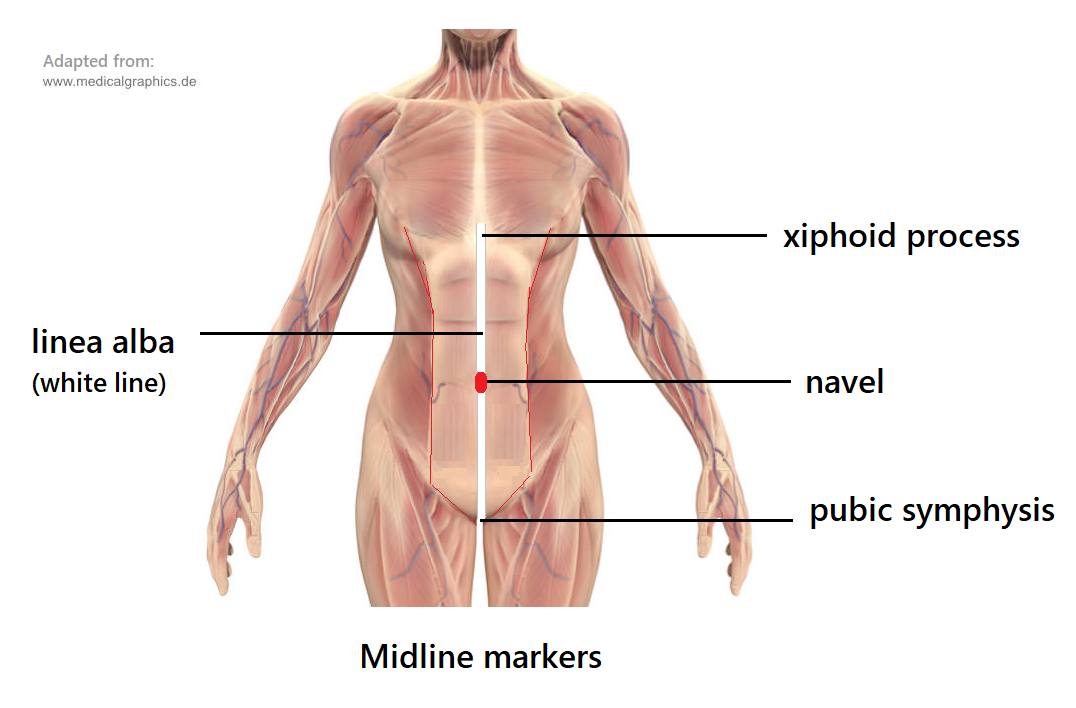
One end of the linea alba attaches to the pubic symphysis of the pelvis and the other end to the xiphoid process of the sternum with the navel situated in the middle.
The linea alba is formed from the aponeuroses (tough, thin sheets of connective tissue) of the three lateral abdominal muscles (the muscles that wrap around the sides of the abdomen - the external abdominal oblique, internal abdominal oblique and transversus abdominis) as left and right sides fuse at the front of the abdomen.

Before the aponeuroses of the lateral abdominal muscles merge at the linea alba they form the left and right rectus sheaths (tunnels of connective tissue) in which the corresponding left and right rectus abdominis muscles lie (like a ribbon in a sheath either side of midline).
The rectus abdominis muscles are the closest muscular tissue to the linea alba, lying either side from pelvis to chest and are the key muscles to focus on to become aware of the relative alignment of the linea alba.
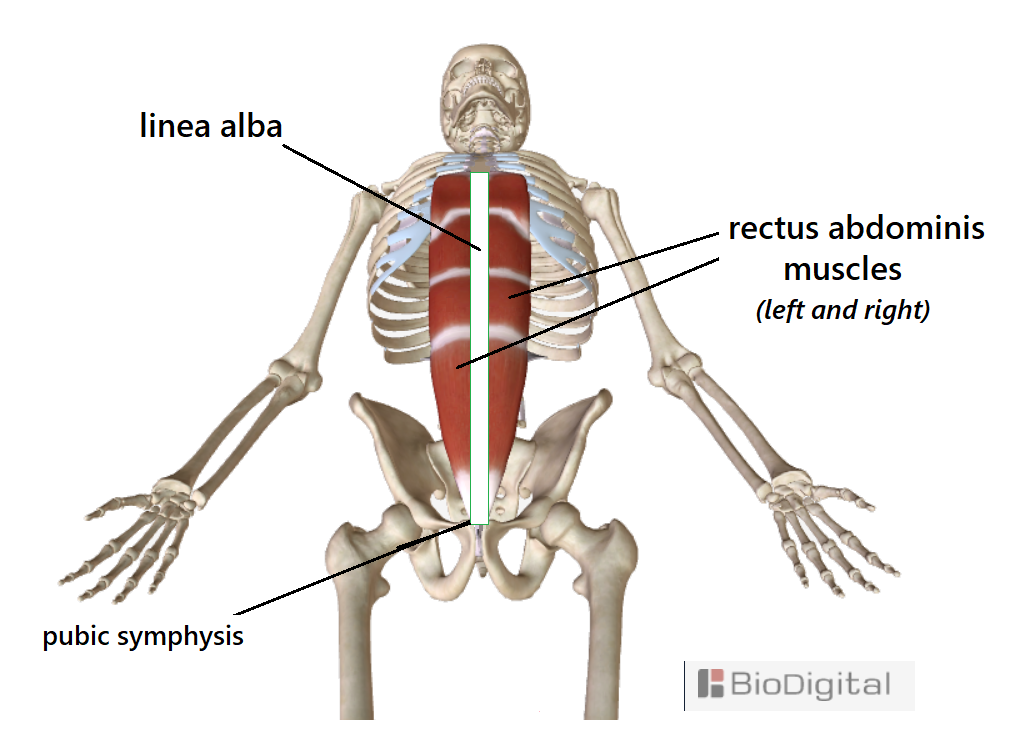
The linea alba and rectus abdominis muscles all originate from the pubic symphysis.
Nuchal and Supraspinous Ligaments.
The nuchal ligament (ligamentum nuchae) and supraspinous ligament are one continuous structure at the posterior of the spine, a long strip of tough connective tissue from "head to tail".
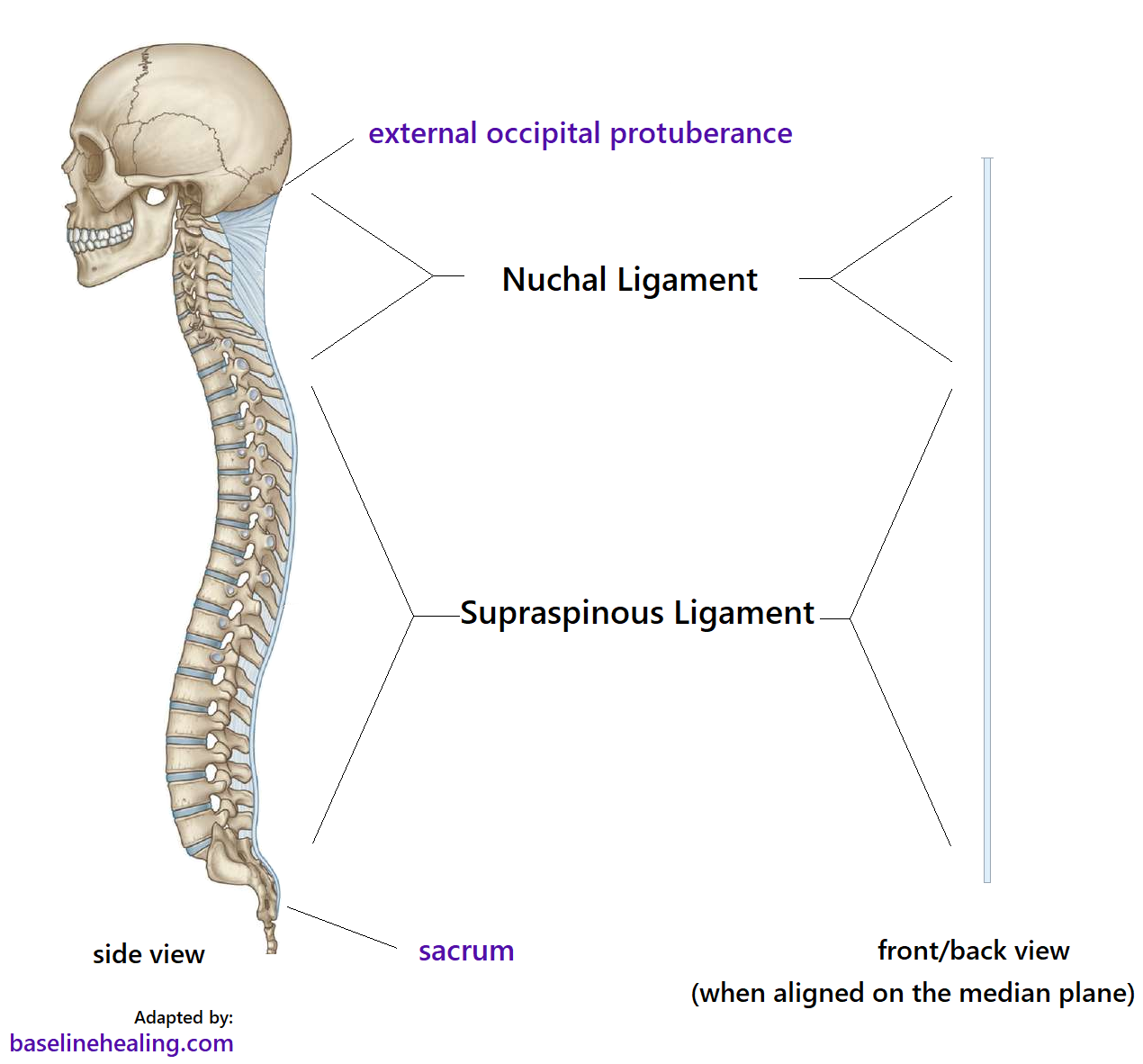
The nuchal ligament is a septum (dividing wall) midline in the back of the neck. It consists of fibro-elastic connective tissue i.e. it is strong with elastic properties.
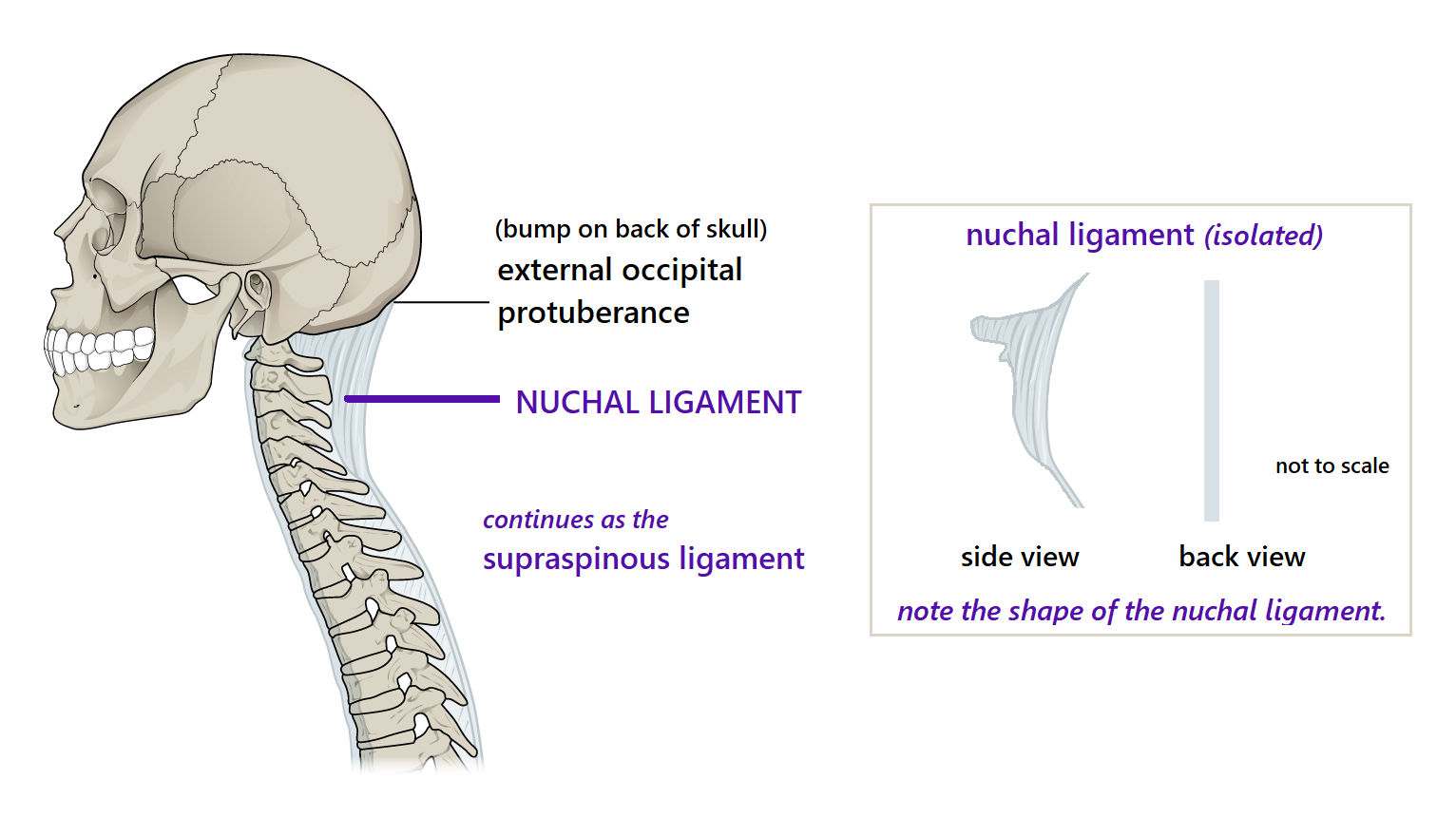
The nuchal ligament attaches to the base of the skull at the external occipital protuberance (feel for the midline bump at the back of the skull) and the medial nuchal line (a.k.a. the external occipital crest).
The nuchal ligament then attaches to the spinous processes of all the cervical vertebrae. At the 7th (last) cervical vertebra, the nuchal ligament continues as the supraspinous ligament, a strong, fibrous cord attaching to the spinous processes of the seventh cervical vertebra, all twelve thoracic vertebrae and the upper lumbar vertebrae, usually terminating at the 4th lumbar vertebra (but possibly L3 or L5).
The left and right trapezius muscles attach to the nuchal and supraspinous ligaments from the base of the skull to the last thoracic vertebra. The trapezius muscles are key to feeling and controlling the positioning of the nuchal and supraspinous ligaments.

Unimportant to my theory, I mention it now to be complete: The anterior longitudinal ligament is the longest anatomical structure on the midline. Running the entire length of the spine and attaching to the anterior (front) of each vertebrae, it cannot be 'felt', either by palpation or by focusing on adjacent muscles.
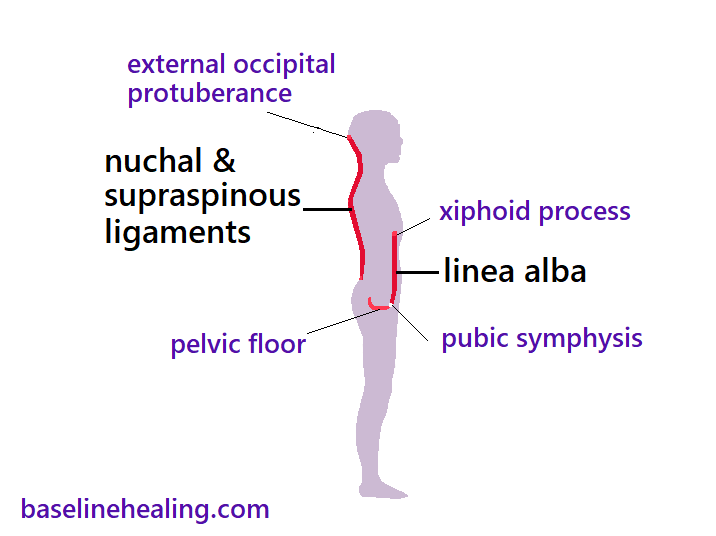
Increasing Conscious Awareness of Midline.
To increase conscious awareness of our midline we can tap into the proprioceptive feedback (sensory information regarding positioning, motion and balance) generated by various structures by actively focusing on them.
Muscles and other structures that are on, or either side of, midline include:
- The pelvic floor muscles. A group of muscles forming a 'basket' at the base of the linea alba.
- Perineal muscles. Anal sphincter.
- The clitoris/suspensory ligament of the penis located at the pubic symphysis.
- The rectus abdominis muscles either side of the linea alba.
- The trapezius muscles attaching to the nuchal and supraspinous ligaments.
Much information about the relative positioning the head can be gained from:
- Nostrils. Feel the air flow in each nostril, aiming for balance.
- Movement of the mouth, lips and jaw.
- The tongue. Positioning the tongue behind the central incisors and on the hard palate provides sensory feedback about midline.
Dynamic Alignment and Balance.
The body is not static. We are constantly on the move and thus true balance and alignment are dynamic states.
The body is aligned when:
- Our midline anatomy can be at maximal extension on the median plane.
- The body balanced either side of the median plane.
- Midline anatomical structures are positioned in the correct relative positions to allow a full range of natural movement.
- The body is stable.
- Movement is fluid.
- The body is free of physical restrictions that would otherwise apply tensions and restrict range of movement.
The linea alba, nuchal and supraspinous ligaments are like a ribbon/ rope/band that can bend and twist at every level, supporting the rest of the body when we have a full range of natural movement.
Think about where your midline anatomy is in relation to the median plane.
Feel for your state of balance and alignment.
BaseLineHealing.com the median plane. linea alba. nuchal & supraspinous ligaments.